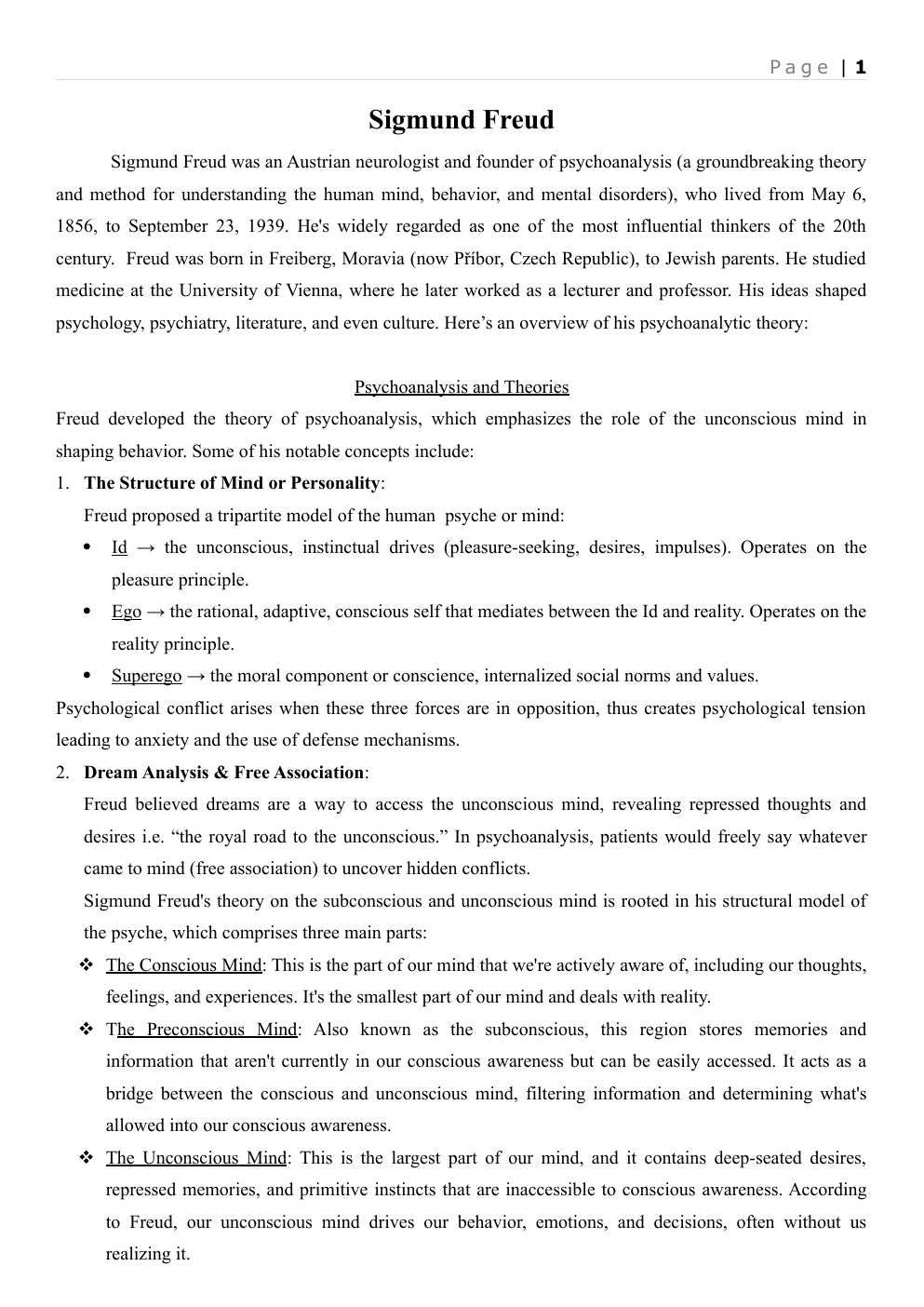Sigmund Freud (présentation en aglais)
Publié le 28/08/2025
Extrait du document
«
Page | 1
Sigmund Freud
Sigmund Freud was an Austrian neurologist and founder of psychoanalysis (a groundbreaking theory
and method for understanding the human mind, behavior, and mental disorders), who lived from May 6,
1856, to September 23, 1939.
He's widely regarded as one of the most influential thinkers of the 20th
century.
Freud was born in Freiberg, Moravia (now Příbor, Czech Republic), to Jewish parents.
He studied
medicine at the University of Vienna, where he later worked as a lecturer and professor.
His ideas shaped
psychology, psychiatry, literature, and even culture.
Here’s an overview of his psychoanalytic theory:
Psychoanalysis and Theories
Freud developed the theory of psychoanalysis, which emphasizes the role of the unconscious mind in
shaping behavior.
Some of his notable concepts include:
1.
The Structure of Mind or Personality:
Freud proposed a tripartite model of the human psyche or mind:
Id → the unconscious, instinctual drives (pleasure-seeking, desires, impulses).
Operates on the
pleasure principle.
Ego → the rational, adaptive, conscious self that mediates between the Id and reality.
Operates on the
reality principle.
Superego → the moral component or conscience, internalized social norms and values.
Psychological conflict arises when these three forces are in opposition, thus creates psychological tension
leading to anxiety and the use of defense mechanisms.
2.
Dream Analysis & Free Association:
Freud believed dreams are a way to access the unconscious mind, revealing repressed thoughts and
desires i.e.
“the royal road to the unconscious.” In psychoanalysis, patients would freely say whatever
came to mind (free association) to uncover hidden conflicts.
Sigmund Freud's theory on the subconscious and unconscious mind is rooted in his structural model of
the psyche, which comprises three main parts:
The Conscious Mind: This is the part of our mind that we're actively aware of, including our thoughts,
feelings, and experiences.
It's the smallest part of our mind and deals with reality.
The Preconscious Mind: Also known as the subconscious, this region stores memories and
information that aren't currently in our conscious awareness but can be easily accessed.
It acts as a
bridge between the conscious and unconscious mind, filtering information and determining what's
allowed into our conscious awareness.
The Unconscious Mind: This is the largest part of our mind, and it contains deep-seated desires,
repressed memories, and primitive instincts that are inaccessible to conscious awareness.
According
to Freud, our unconscious mind drives our behavior, emotions, and decisions, often without us
realizing it.
Page | 2
3.
Sexuality and Development:
Freud's psychosexual development theory proposes that personality development occurs through stages
erogenous zones”, each characterized by....
»
↓↓↓ APERÇU DU DOCUMENT ↓↓↓
Liens utiles
- commentaire de texte sur l’extrait de Le Moi et le Ça, Sigmund Freud, 1923
- Explication de texte autour d'un extrait de l'ouvrage Le poète et l'activité de la fantaisie, de Sigmund Freud
- Texte d'étude : Sigmund Freud, Le Malaise dans la civilisation - comment la civilisation peut-elle répondre à l'agressivité ?
- COMMENTAIRE DE TEXTE Études sur l’hystérie, Josef Breuer et Sigmund Freud
- SOUVENIR D’ENFANCE DE LÉONARD DE VINCI (UN), Sigmund Freud (résumé & analyse)

































